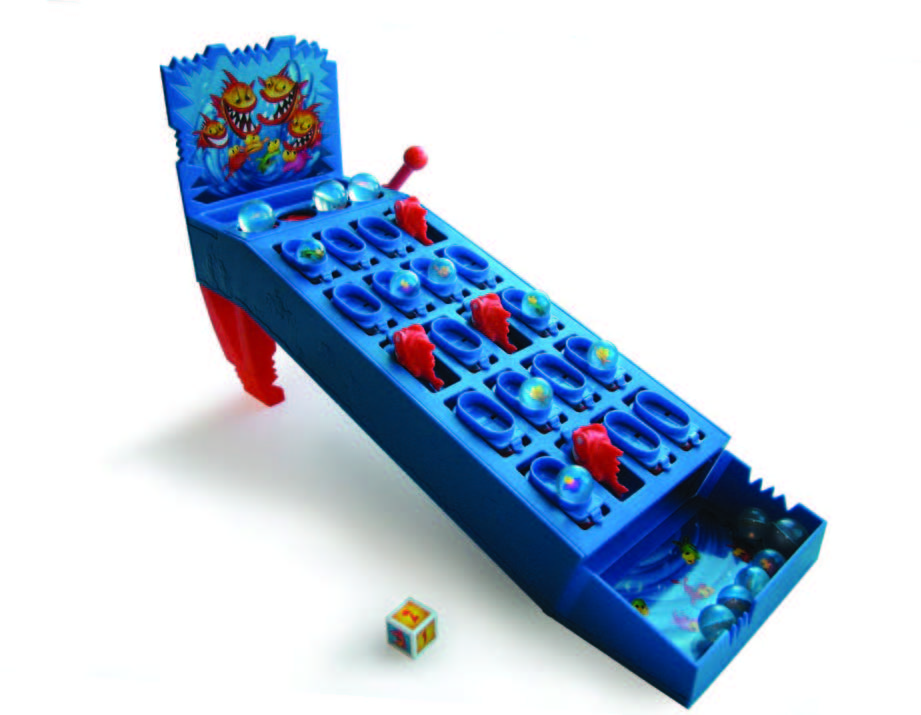
He-Man and Voltron action figures no longer rule the toy store. And while there are a few classic games and toys that seem almost guaranteed to remain popular forever, like Monopoly and Barbie dolls, even these favorites need helpful extras each year to keep sales brisk. (Witness Barbie Girls: A doll that doubles as an MP3 player and also instantly links girls to an interactive website.)
Keith Millman ’99, who studied mechanical engineering as an undergraduate, knows all this and pretty much everything else there is to know about toys. He knows who designs them, who manufactures them, and how long they’ve been selling. But Millman isn’t your average toy enthusiast; he’s a professional toy inventor.
Together with his business partner, Westley Ciaramella, Millman owns and operates Catapult Concepts, a toy inventing company the pair launched in 2004. They currently have three toys on store shelves: their successful Piranha Panic, a small table-top game involving dice, marbles, and plastic piranha that threaten to send players back to “start”; a card-balancing game of skill called Shakedown; and Barbie Gymnastics Divas Twirl Team (the duo invented a way to make Barbie twirl a ribbon in one hand while performing a backspring crowned by a split).
Millman, who loved playing with Legos as a kid, landed his first real job after graduation from Hopkins back in his hometown of Hillsboro, New Jersey—in a strip mall.
“All my friends were going to law school or working in big-time finance jobs and I was working retail in a toy store,” he says. “But, I knew that to be an inventor, I needed to know what manufacturers were doing and where the trends and industry were going.” With a notebook always on hand, he recorded toy brands and manufacturers, new advances in technology, and sketches of his own toy ideas. By summer’s end, he knew exactly what role he’d play in the toy industry.
“I realized inventing would be a mix of engineering and design; everything I like, from imagining to executing a product and solving all the mechanical problems in between.” That fall, he entered the nation’s premier toy design program at New York’s Fashion Institute of Technology, where he later befriended Ciaramella. “For my application portfolio, I included some toy designs I had done but also used an AutoCAD drawing I had done in a senior year engineering course. I do think being an engineer from Johns Hopkins definitely helped my application.” Completing the two-year program in 2001, Millman joined Big Monster Toys (BMT), one of the nation’s leading toy design firms. After three years with the company, he was itching to start his own. The following year, he wrote a business plan, raised the necessary start-up funds from friends and family, and he and Ciaramella launched Catapult Concepts.
The partners set up shop in the basement of an apartment complex in Long Branch, New Jersey. “With help of a family connection, we rented an apartment on the first floor to live in and used the basement as our workspace and office,” Millman recalls. “We even bought some of our work equipment off eBay, things like a metal working lathe, a mill, a vacuum form machine. Our shop kind of looks like a high school woodshop classroom.”
The start-up company experienced success almost immediately. “In our first year, we had three Mattel products, which is amazing,” Millman says. “Two made it to the shelf—our Piranha Panic game and a new feature for stuffed animals: a way for a stuffed cat’s eyes to close and its head to tilt when it’s being petted,” he explains. “If next year it goes to a dog, we will get an additional royalty.”
In the past two years, the pair has sold six more ideas. “Since it’s all still proprietary information I can’t talk about the actual products,” Millman says, but adds, “I can say that there is a game, a feature doll, a card game, and one is… a girls’ product.”
Though Millman today is light-years away from working retail at the mall, he still gauges the market the same way he did when he was fresh out of Hopkins.
“We go to the toy store a lot. Walking down the aisle, we know what’s considered a hit, who is gaining market share over whom, what toys are doing well, and where there’s room for something new,” he says. “We’re constantly thinking about toys.”




